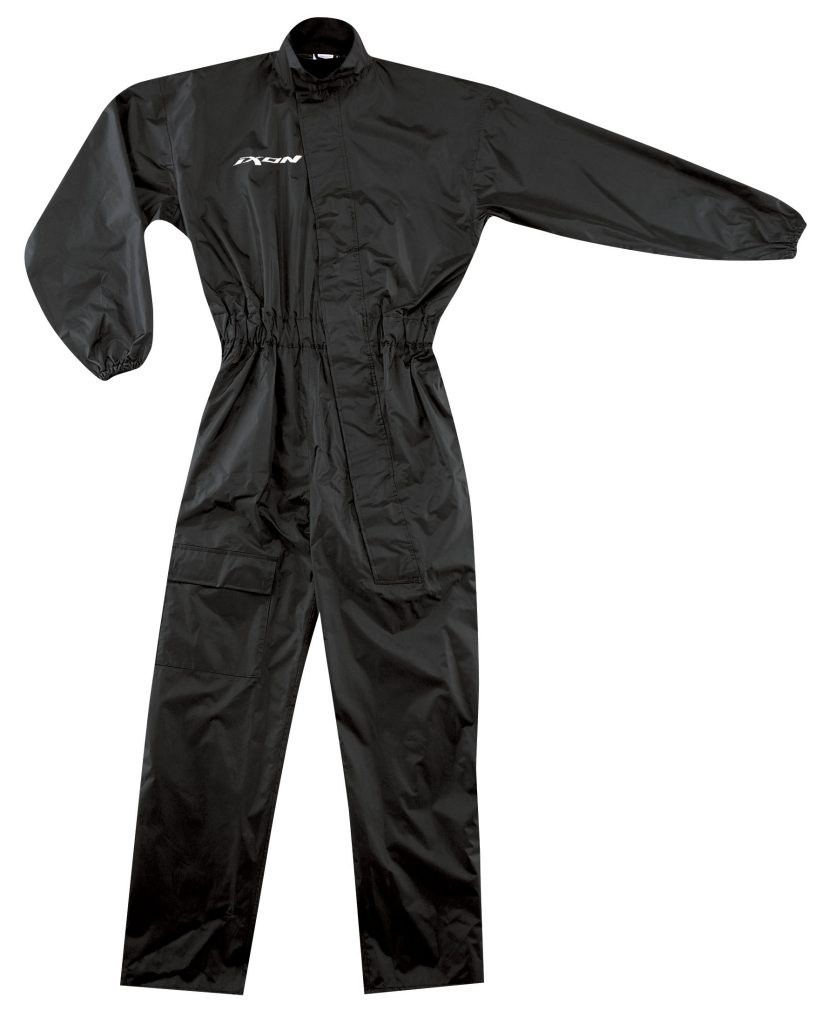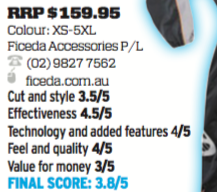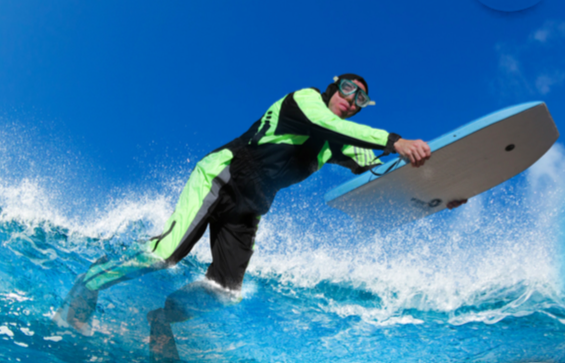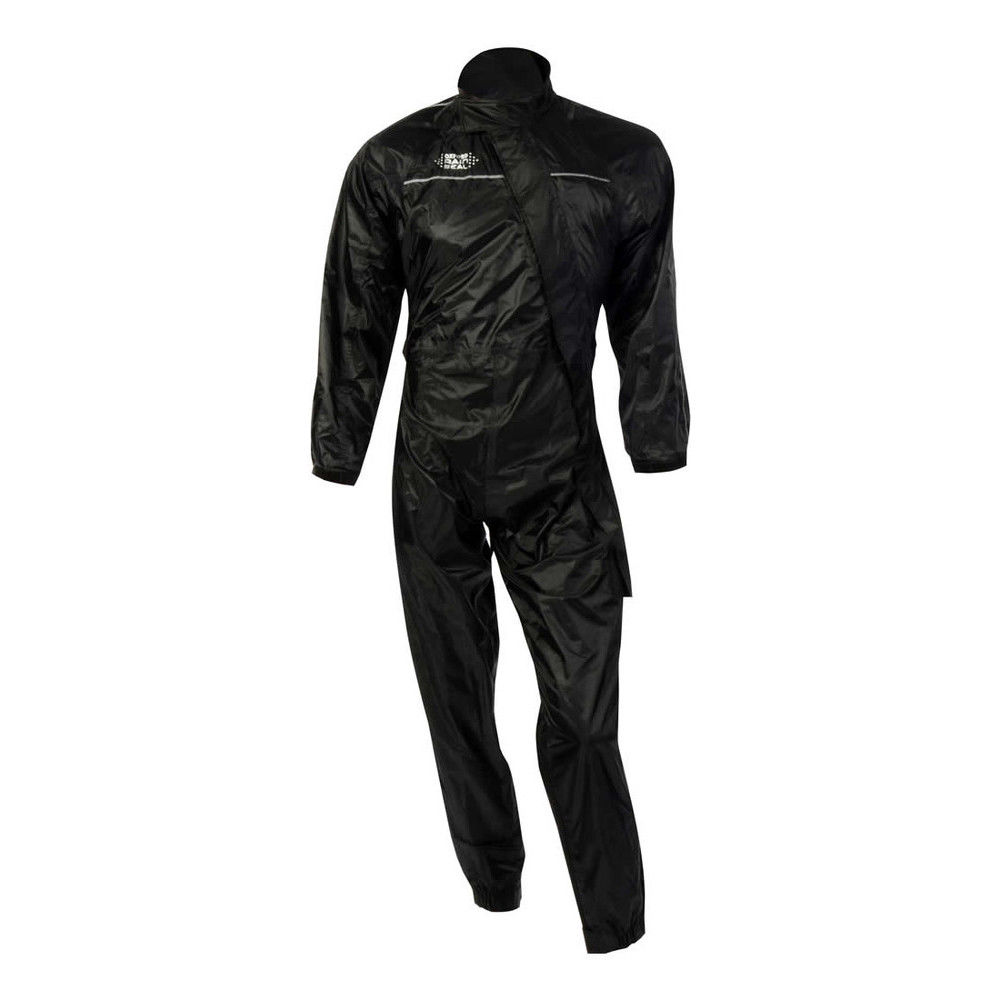AMCN staffers put their magnificent seven winter suits to the test
“There’s no such thing as bad weather, only unsuitable clothing”. This quote by famous author Alfred Wainwright translates broadly to all exploits involving adventure in the great outdoors, and motorcycling is no exception. Being an all-season rider is easy when you have the right gear and it only takes one self inflicted dose of hypothermia to learn the importance of staying warm and dry in the saddle. Nonetheless, even veterans get caught out when winter rolls in and you’re left lamenting last season’s gear which looks more ‘breathable’ rather than ‘waterproof’. At 100km/h on the freeway, a mild soaking and fresh winter’s breeze can quickly turn your commute into a dastardly blizzard cold enough to freeze the balls off a brass monkey. The joy of motorcycling is hard to appreciate when your shaking like you’ve got palsy and cursing the set of waterlogged leathers that are now clinging to you like a 1” thick burka of indestructible licorice.
But there’s really no need to be unprepared as an abundance of high quality, one-piece rain suits are available to meet all budgets, shapes and sizes.
One of the most effective ways to prevent looking like a rookie this winter, or worse still leaving the bike in the shed, is to invest in a one-piece rain suit that covers your usual riding kit and protects you from those inevitable winter rain storms. The addition of a well constructed waterproof over suit to your wardrobe can transform a rain soaked ride from expletive filled, slog fest to a dry doddle without breaking the bank. This lightweight kit is essential if you plan on touring or commuting in a range of weather conditions and we’ve taken the guesswork out of it by putting seven of the best suits available on the market to test.
RST Storm
Straight away the RST Storm felt more robust and substantial than any of the waterproof over-suits I’ve had in the past. The thickness of the outer material with the addition of a full lining makes the RST not just a waterproof barrier but also an effective extra thermal layer for extreme cold. A strong wide waist band adds to this by keeping the suit cinched in close around the midriff. Although I’m the smallest guy in the team, and usually wear size small or medium in any clothes and riding gear, the size large RST Storm was perfect for me. I can wear it over bulky winter riding gear without it being too tight, or over lighter summer gear without it flapping around wildly. Climbing into the suit is easy regardless of what gear I’m pulling it over thanks to generously long zipper on the front and legs, and I find the combination of an elasticated section with Velcro straps on the cuffs a good multi-fit solution which isn’t overly bulky. The neck is high enough to prevent water ingress, soft enough to not be irritating, and the Velcro strap at the back will accommodate neck sizes from Twiggy to Schwarzenegger. As with any suit, ensuring the Velcro flap covering the front zip is fully and evenly fastened is important to guarantee no leaks, and with this done I found the RST Storm 100% reliable. Paul Young (H: Hobbit-like W: 60kg dripping wet)
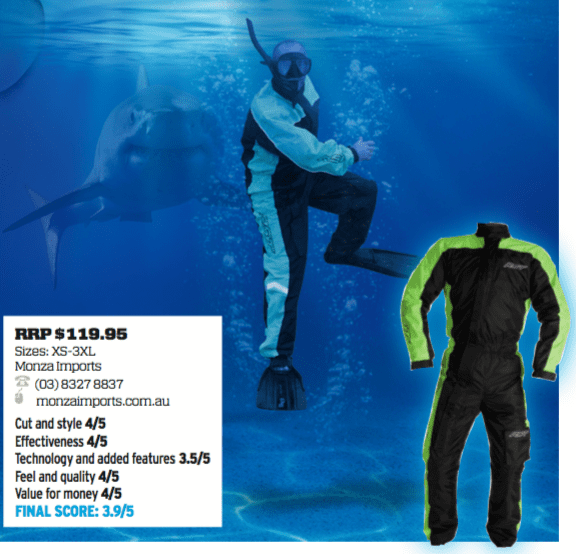
Rjays Tornado
To be totally upfront about this, I am not a huge fan of “onesey” rainsuits. They make me feel like I’m wearing a giant plastic bag, but I did feel a whole lot better when I saw 193cm Sean Muir wearing his. There’s a giant, skinny condom if ever I’ve seen one.
The best thing about testing the Rjays Tornado suit was that it would stop raining as soon as I put it on. A couple of times it stopped raining when I just thought about being able to give it a good test on the commute home. Amazing. As the owner of a pair of Rjays leggings for the last few years I am a big fan of their rain gear although, being in Melbourne, I obviously don’t get to put it to the test very often. The Tornado is built to a price and that shows in the quality of the zips, the threads that haven’t been cut off and the minimal waistline attachments for the perforated nylon lining that’s supposed to ease it over your jacket.
The external breast pocket for your wallet and keys means you don’t have to get naked at the servo, although I did ziplock bag the mobile before putting it in there. The length of the Large size was fine for my 182cm. Overall, pretty impressed. Wolter Kuiper (H: 185cm W: 75kg)
Ixon R8.1
I absolutely punished this Ixon 8.1 by notching up over 500kms in torrential downpours on a recent road test, as well as two solid days sliding my way through mud and sludge off-road. Considering it’s Ixon’s base model one-piece I was suitably impressed by the durable double leg Velcro tabs, and the addition of a large single outer pocket which kept my phone, bank cards and wooly hat dry (no zip lock bags required!). Water didn’t exactly find it’s way in, it was generated inside the suit by body heat in the form of condensation but in fairness this is an issue across the board with all waterproof suits I’ve come across. The taped in-seams held up well to abuse and remained water tight however the front zipper did require a delicate touch at times to prevent it from interfering with the elasticated waist. At this low price-point I can’t fault it but if I had more cash to splash I’d opt for something with a belted waist and more durable zipper – particularly if this suit was going to be relied on as part of my year-round riding apparel.
The long overlapping asymmetrical flap kept both wind and water out but this suit was let down a little by a neck seal that had limited adjustability and felt constricted when fastened. I managed to get away with this by keeping it slightly open and sliding a thin neck warmer underneath but a little more Velcro and an adjustable overlapping neck flap could’ve improved the situation. I can recommend the Ixon R8.1 to very thin necked individuals who are looking for a low-priced oversuit to get them out of trouble this winter. Paul McCann (H:183cm W: 80kg)
Ixon R8.8
It is simple to put on with a hardy zip running from crutch to neck and an added Velcro strip for an even better seal. It’s made of durable PVC polyester and has fabric reinforcement on the outside of the sleeves, and although you’re not wearing a rain suit to win any fashion competitions, it is well styled with some reflective sections. You can also fold the whole suit into a built in bag, then clip it around your waist. And most importantly, during my hour-long commute in hard rain, it did not let one drop of water in at the elasticised wrists or tall collar.
The legs, however, were short. This was not helped by the ankle seals (Velcro rather than elastic), or by the shoe straps, which just ended up unbuttoning. It may be worth going for a size larger than your usual. I would have also liked a zip-up pocket on the outside of the suit too – a little thing, but one that I feel entitled to if I’m paying top dollar. The R8.8 is a great suit, but given the price I would try some other options too. Mark Vender (H: 189cm W: 90kg)
Held Mosun
The Held Monsun 6010 one-piece rain suit fits my long arms and legs perfectly thanks to the adjustable arms and snug-fitting storm cuffs. The knee-high zips allow the suit to slip over boots yet tighten enough to prevent water penetration and wind flapping. The diagonal labyrinth zip is designed to open the suit wide so its easy to pull on over the top of bulky riding gear.
The fabric is a 100% polyamide and doesn’t make you feel like you are slowly cooking when the rain stops falling. Safety is provided by 3M-Scotchlite reflector on the arms, legs and back. I tested the suit during the big east coast low and remained bone dry and warm. The hood material is thin enough not to make my helmet any tighter. Other suits suffer water leakage around the neck hole, the integrated hood totally eliminates this on the Held unit.
There is no storage pack and it’s a little bulkier than other rain suits, but it fits into a pannier with ease. I stored my mobile phone in the waterproof pocket and it remained bone dry. One negative is that once you have secured the integrated hood it’s almost impossible to get access to the waterproof pocket located in the left breast of the suit without undoing the Velcro strap on the hood, requiring removal of your helmet strap.
All the velcro straps, elasticated areas and zippers are quality, however, the ankle to knee zips catch the liner. There is no adjustable belt at the waist, instead it was a snug-fitting elasticated waist which also makes doing up the suit a little tricky.
The Held suit requires a $150 investment, but come the day when you are facing hours of wet weather riding, this will seem like a bargain. Chris Dobie (H: 192cm W: 89kg)
Oxford Rain Seal
I found my suit to be 100% effective in keeping me dry as no water penetrated the suit at all on our test day at the front of the office, or during a multi-day ride in heavy rain.
I also found the suit to be a very effective wind breaker when combined with gauntlet style gloves to cover the cuffs, and a neck sock under my helmet to prevent cool air from penetrating the suit. The fit was great for my shape and I found it very wearable both on and off the bike. I had no restricted movement whatsoever and it pulled on over my Kevlar jeans and riding jacket very easily. The only negative thing that I have to say about it is that the wide ankle flares are a bit annoying to zip up because the weather proof flap has a habit of getting snagged in the zip. If it wasn’t for that I would probably have to give it a perfect score as it did everything extremely well. In my opinion the Oxford Rain Seal offers very good quality for the coin. Darren Kersey (H: 178cm W: 84kg)
RJays Tempest
A strange confidence comes over me when I put on the RJays Tempest. It’s a kind of juvenile enthusiasm at the prospect of being impervious to the elements. I want jump in puddles, race twigs down the drain and, of course, ride with a big, stupid grin on my face.
That’s because the Tempest is 100 per cent waterproof, thanks to its lightweight seam-welded material, and is 100 per cent breathable. That means just about all the discomfort of wet weather disappears when you ride, leaving just the fun. The fact that the tempest has fluorescent yellow panels down the sides and reflective strips on the shoulders – something I’d normally avoid – somehow adds to the joy. I know the panels and strips are designed to stop drivers running me down – since rain seems to make most drivers funny in the head – but I like the look, too. It says, I’m dry and I don’t give a cuss. If you don’t agree, it comes in black, too. Practicality-wise, the neck has Velcro adjustment and a soft lining, the waist and cuffs have elastic for a snug fit, the ankles are adjustable, there’s a carry bag and a large, easily accessed pocket on the right leg, so you don’t have to fumble around trying to get your wallet out of your jeans at the fuel station. If you do leave your wallet in your jeans, the suit is lined to make it slide on and off over motorcycle gear easily.
My only quibbles with the Tempest are caused by my impractical body shape. At 193cms tall and 86kg, my legs and torso are too long, which means the pants ride up and my shoes aren’t as protected as I’d like. I’ve been wearing an XL, but the neck – even tightened – is too loose and allows water in. Sean Muir (H: 193cm W: 86kg)
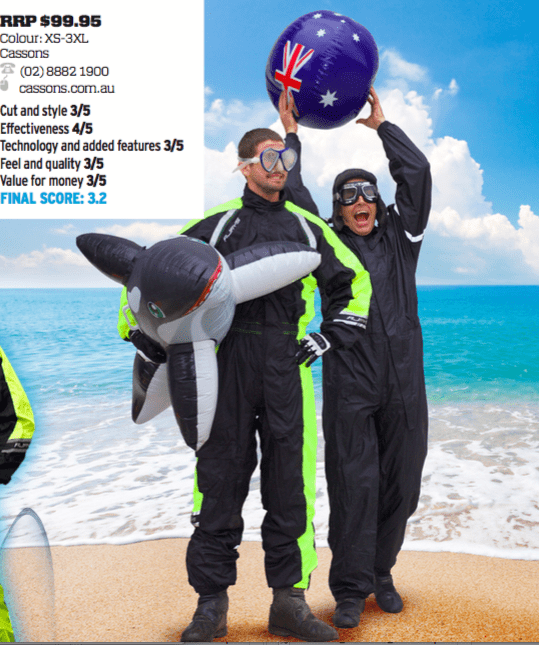
One-piece suit testing criteria
To give you some insight into our testing regime we’ve listed the testing criteria used below. In this instance we’ve applied equal weighting to each criterion, but we understand that each rider will have different priorities so you can decide what aspect of the suit are most important in your book.
Cut and Style (20%):
How well to the dimensions fit your body type and how does it look? Has it got stylish safety features that add to the design?
Effectiveness (20%):
How well does the suit prevent water ingress – tested in the AMCN Horror HQ laboratory, and on the road while commuting during a 2-week period.
Technology and added features (20%):
Visual assessments of in-seams, inner lining materials, and outer shell construction before and after sustained use. Higher marks for those with pockets, storage packs and effective stirrups.
Feel and quality (20%):
Does the suit slide easily over riding gear and do the zips, buttons, flaps feel secure and well constructed / durable?
Value for money (20%):
How does the suit stack up in terms of price to the others on test with regards to the quality of materials used and the overall design?
By Paul McCann



